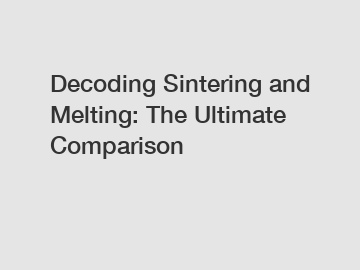Decoding Sintering and Melting: The Ultimate Comparison
Link to JINTAI
In the realm of material science and manufacturing, two crucial processes play a fundamental role: sintering and melting. Often misunderstood or used interchangeably, these processes have their unique characteristics, applications, and effects on materials. In this blog, we will delve into the depths of sintering and melting, decoding their intricate workings, and drawing comparisons to uncover their ultimate distinctions.
Understanding Sintering:

Sintering involves the compacting and heating of powdered materials below their melting points, creating a solid mass. This process effectively fuses particles together, driving atomic diffusion and bonding, resulting in a material that possesses cohesion and strength. Sintering is extensively used in various industries, including automotive, aerospace, electronics, and even in the production of everyday household items such as ceramics, glassware, and metal parts.
The Science Behind Sintering:
During sintering, as the temperature rises, the particles undergo various stages of transformation. Initially, the particles are packed loosely, allowing for void spaces. As the temperature increases, these voids decrease in size, leading to particle rearrangement and densification. At higher temperatures, the process of viscous flow occurs, where particles rearrange further and undergo grain growth, enhancing the material's strength. However, it is important to note that sintering does not result in complete melting of the material; rather, it forms a highly compacted structure that is still distinct from the liquid state of matter.
Applications of Sintering:
Sintering finds widespread applications in diverse industries. For instance, in the automotive sector, sintering is employed to produce intricate metal components with high precision and strength, such as gears, bearings, and camshafts. Similarly, the electronics industry utilizes sintering to create ceramic substrates, circuit boards, and semiconductors. Additionally, sintering is instrumental in crafting ceramic art pieces, bricks, and even dental implants. Its ability to create intricate shapes and achieve desirable material properties makes it an indispensable manufacturing process.
Understanding Melting:
Melting, on the other hand, is a phase change process wherein a solid substance transitions into its liquid state, typically due to the application of heat. It involves breaking the intermolecular forces between particles, allowing them to move freely and assume the shape of their container. Melting is a critical step in various manufacturing processes such as casting, molding, and additive manufacturing using techniques like 3D printing.
The Science Behind Melting:
As heat is applied to a solid material, its atoms or molecules gain kinetic energy, leading to increased molecular movement. At a specific temperature, known as the melting point, the intermolecular forces weaken, allowing the solid material to transition into a liquid state. This phase transition unlocks the material's potential for various applications, such as the creation of complex shapes through casting or the formation of new alloys.
Applications of Melting:
Melting plays a pivotal role in numerous industries. The metallurgy sector relies heavily on melting processes to produce a wide range of materials, including iron, steel, aluminum, and copper alloys. Similarly, in the plastic and polymer industry, melting facilitates the molding of products like bottles, toys, and packaging materials. The realm of modern additive manufacturing heavily involves melting, enabling the construction of intricate design prototypes and even functional end-products.
Decoding the Distinctions:
While sintering and melting both involve heat-induced transformations of materials, a few key distinctions set them apart. Sintering retains the solid-state nature of the material, albeit highly compacted, while melting transforms the material into a liquid state. Sintering relies on atomic diffusion and bonding to form cohesive structures, whereas melting permits malleability and shape changes of the material. These differences in fundamental behavior distinguish the two processes and determine their unique applications and manufacturing capabilities.
Conclusion:
Understanding the nuances of sintering and melting is crucial for anyone involved in material science and manufacturing. Sintering, with its ability to create strong and precise components, is an invaluable process in various industries, while melting allows for the formation of complex shapes and the creation of new materials. By decoding and comparing these processes, we gain insights into their distinct characteristics, thereby empowering us to harness their potential for innovation and advancement in manufacturing technology.
If you want to learn more, please visit our website.
Contact us to discuss your requirements of what is a sintered filter. Our experienced sales team can help you identify the options that best suit your needs.



